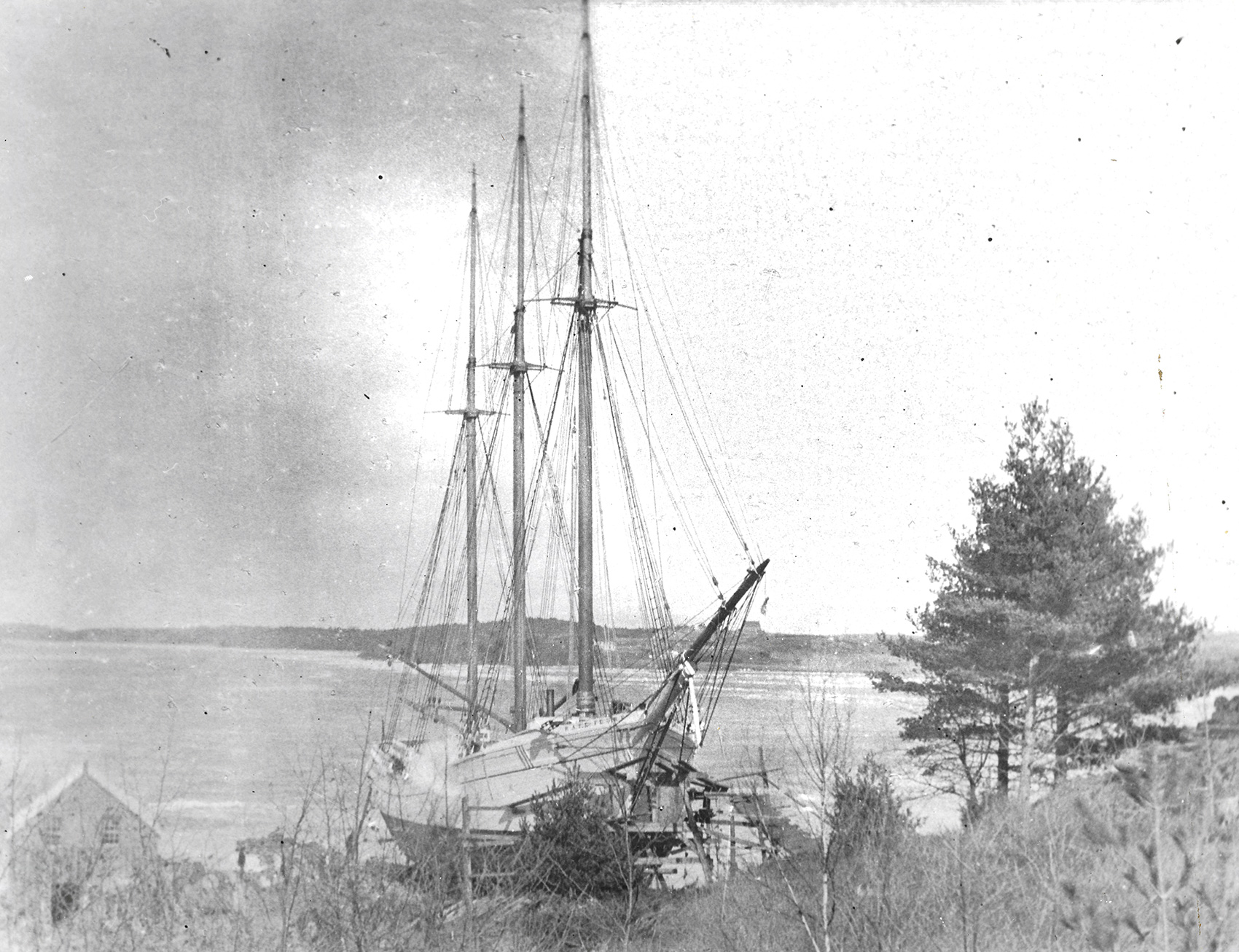
Neither Captain E. L. Whitney nor his six crewmen suspected any trouble that fine autumn morning. Dressed in ordinary work clothes, Whitney, 32, watched closely while his first mate, R. B. Bush, and the bosun, a man named Erickson, directed the two seamen on board, Rudolph Carstin and a man named Hatten, and the only deckhand, one Julius, as they cast off hawsers and raised the mainsail on September 15, 1909. While the crew bustled on deck, ship’s cook D. Feurtado doubtless double-checked his galley stores and looked to his pots and pans. The men had every confidence in their ship, a trim three-masted, 315-ton schooner with a bright coppered hull named the Kate Feore.
Built only seven years earlier in Phippsburg, Maine, she belonged to James J. Feore, who named her for his mother. Feore was a Québécois stevedore who had prospered, relocated to the Gulf Coast and bought extensive Mississippi timberland. By the turn of the century, he operated a successful lumber fleet out of Mobile consisting of 23 schooners, several of them steel-hulled.
On what would prove to be her last voyage, the Kate Feore carried 500 tons of pitch pine lumber for Matanzas, Cuba. In the ship’s log, Capt. Whitney recorded a light northeast wind and fine weather, all sails set, and “pumps, lights and lookout carefully attended.” The following day, September 16, remained clear with a light northeast wind, and the schooner glided along at a sedate four knots. Two days later, the captain described clear skies but increasing wind and “a heavy sea rolling down.” A falling barometer augured bad weather, so Whitney ordered the crew to stow the topsails and reef the mainsails. The men donned their oil coats, hats and sturdy sea boots for the coming blow. Late that afternoon, a fierce squall struck, and the ship bowled along under bare poles. On the 19th, a violent West Indian hurricane followed. Whitney proudly wrote of his sea-worthy craft, “Vessel still scudding and making pretty good weathering of it.”
Unfortunately, the next day conditions worsened. Terrific winds blew the sails “off like paper,” the ship “commenced leaking” and even two strong men at the wheel could not hold her course. Whitney ordered the deck cargo jettisoned to lighten the vessel and wrote, “All hands doing their very best to save ship.” Then the pumps quit, and crewmen had to cut the wind-damaged mizzenmast away. By 9 a.m., all the masts and rigging were gone. As the vessel wallowed flush with the Gulf’s roiling surface, the men desperately lashed themselves to the skylight. Tragically, a large wave swept Julius away.
The Grand Isle Hurricane, as it soon became known, slammed into southern Louisiana on September 21 as a Category 3 storm that killed over 300 people. Given its small span, with a hurricane-force wind field only 32 miles across, damage at Mobile proved light to moderate. During the following week, as work gangs cleaned up the mess along the wharves, ships limped into various Gulf ports seeking repairs, and their crews told incredible stories. The dismasted schooner General Whiting arrived at New Orleans with the help of a tug. The steamer Harry T. Inge eased into Mobile’s L & N Fruit Wharf “bearing the marks of a fierce battle with hurricane winds and high seas.” The captain of the bark Oakland, also at Mobile, declared, “I can say it was as hard a storm and as high winds as I ever encountered, and I have sailed the seas since I was a boy.”
But what of the Kate Feore? The captain of the Thomas G. Smith, whose vessel ran aground at the mouth of the Mississippi River, told a reporter that he had seen her running with the storm on September 18; he hoped that she “finally got out of it to some place of safety.” Meanwhile, the missing crew’s friends and family anxiously waited for more news.
Out on the Gulf, September 22 brought flawless skies and a calm sea. Capt. Whitney and his men could not believe their luck. While they mourned Julius, they had survived. Their schooner remained afloat, barely, thanks to the lumber below decks keeping her buoyed. But the vessel was a hopeless wreck, dismasted and adrift. After a quick search, Whitney found “a few cans of food but no water.” At 4 a.m. the following morning, they spotted a steamship but had no matches to make a fire. Their thirst worsened, but providentially it rained, and the men captured five gallons, which Whitney rationed at a pint a day.
Each glowing dawn meant renewed hopes for rescue, followed by crushing disappointment at deepening dusk. They sighted several ships but rode too low in the water to be easily visible from any distance. Their water ran out and eating the salty canned food exacerbated their thirst. On October 2, Whitney reported Carstin “getting very weak,” and two days later, “getting weaker.” After what must have seemed an eternity, the steamship Winifred rescued them at 4 p.m. on October 8 and took the schooner’s hulk in tow. They had been 18 days adrift. Unfortunately, Carstin died on board the steamer; Whitney recorded his burial at sea that night. The others managed to hold on until they got to the Port Arthur, Texas, hospital where they soon regained their strength. James Feore received the news by telegram, and according to the local press, “There was much rejoicing in Mobile.” Soon, Whitney and the others returned to work. Fortunately for Feore, insurance made good the economic loss.
But there was a poignant coda, “mute testimony of storm-tossed suffering sailors.” Over a year after the storm, on December 11, 1911, a Texas newspaperman sent word of a heart-wrenching discovery to the editors of the Mobile Daily Item, who duly shared the news with their readers.
According to the correspondent, several carpenters had recently gathered at the Port Arthur shipyard to repair and reseal a storm-battered hulk. They had done this kind of thing often, and they confidently clambered aboard the Kate Feore with their mallets, irons, oakum bales, tar buckets and brushes. As they walked along the deck inspecting the broken masts, smashed bulwarks and warped, split boards, they stopped at the main hatch cover. Bending closer, they discerned rudely carved messages. Under the date of September 26, they read, “Waterlogged six days; beginning to suffer agony for want of water and grub.” On the 27th, “Nothing in sight; suffering intense.” On the 28th, “Agony, agony. Water, water; now I’ll—.” The last inscription, “scrawled and scratched over a wavering line,” and dated October 1, read, “About gone; good-bye wife, mother, babes.” It was signed “E. L. Whitney.” The amazed workmen dropped their tools and immediately contacted the local newspaper.
The correspondent did not specify what happened to the hatch cover. Did it remain on the Kate Feore, which ended up a coastal barge, or did someone remove it as a souvenir? If the latter, perhaps it is out there, in a garage or a living room somewhere, still.
John S. Sledge is maritime historian-in-residence at the National Maritime Museum of the Gulf. The author thanks Michael Feore for access to his family papers for the preparation of this article.






